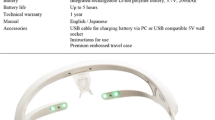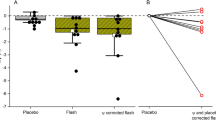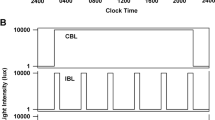Abstract
Introduction
Melatonin and light treatment are recommended for hastening adaptation to time zone change. We evaluated an afternoon regimen of 3 mg sustained release (SR) melatonin with and without next morning green light treatment for circadian phase advance. Effects of melatonin and light were tested separately and then combined to determine if the total phase change is additive or synergistic.
Material and methods
For each condition (melatonin, placebo, light, melatonin plus light), 11 subjects spent from Tuesday evening until Friday afternoon in the laboratory. For all four conditions, the following sleep schedule was maintained: night 1, 2345 to 0630 hours, night 2, 1600 to 0530 hours, and night 3, 2345 to 0700 hours. For the light-only condition, light treatment was administered between 0700 and 0800 hours on Thursday. For melatonin-only or placebo conditions, capsules were administered at 1600 hours on Wednesday. For the combined condition, melatonin was administered at 1600 hours on Wednesday with light treatment between 0600 and 0700 hours on Thursday. Circadian phase was assessed by calculating dim light melatonin onset (DLMO) from salivary melatonin, using a mean baseline +2 standard deviations (BL + 2 SD) threshold. For all four conditions, pre-treatment and post-treatment DLMO assessments were on Tuesday and Thursday evenings, respectively.
Results
Phase advances were: melatonin at 1600 hours, 0.72 h p < 0.005, light treatment from 0700 to 0800 hours, 0.31 h, non-significant, and the combined treatment, 1.04 h p < 0.0002.
Conclusion
The phase advance from the combination of afternoon melatonin with next morning light is additive.


Similar content being viewed by others
References
Arendt J (2009) Managing jet lag: some of the problems and possible new solutions. Sleep Med Rev 13:249–256
Arendt J, Skene DJ (2005) Melatonin as a chronobiotic. Sleep Med Rev 9:25–39
Arendt J, Aldhous M, Marks V (1986) Alleviation of jet lag by melatonin: preliminary results of controlled double blind trial. Br Med J 92:1170 (Clin Res Ed)
Benloucif S, Burgess HJ, Klerman EB, Lewy AJ, Middleton B, Murphy PJ, Parry BL, Revell VL (2008) Measuring melatonin in humans. J Clin Sleep Med 4:1542–1551
Bjorvatn B, Pallesen S (2009) A practical approach to circadian rhythm sleep disorders. Sleep Med Rev 13:47–60
Boivin DB, Duffy JR, Kronauer RE, Czeisler CA (1996) Dose-response relationships for resetting of human circadian clock by light. Nature 379:540–542
Burgess HJ, Crowley SJ, Gazda CJ, Fogg LF, Eastman CI (2003) Preflight adjustment to eastward travel: 3 days of advancing sleep with and without morning bright light. J Biol Rhythms 18:318–328
Burgess HJ, Revell VL, Eastman CI (2008) A three pulse phase response curve to three milligrams of melatonin in humans. J Physiol 586(2):639–647
Burgess HJ, Revell VL, Molina TA, Eastman CI (2010) Human phase response curves to 3 days of daily melatonin: 0.5 mg versus 3.0 mg. J Clin Endocrinol Metab 95:3325–3331. doi:10.1210/jc.2009-2590
Caldwell JA, Mallis MM, Caldwell JL, Paul MA, Miller JC, Neri DF (2009) Fatigue countermeasures in aviation. Aviat Space Environ Med 80:20–59
Cole RJ, Kripke DF, Gruen W, Mullaney DJ, Gillin JC (1992) Automatic sleep/wake identification from wrist activity. Sleep 15:461–469
Crowley SJ, Lee C, Tseng CY, Fogg LF, Eastman CI (2003) Combinations of bright light, scheduled dark, sunglasses, and melatonin to facilitate entrainment to night shift work. J Biol Rhythms 18:513–523
Deacon S, Arendt J (1996) Adapting to phase shifts. I. An experimental model for jet lag and shift work. Physiol Behav 59:665–673
Doljansky JT, Kannety H, Dagan Y (2005) Working under daylight intensity lamp: an occupational risk for developing circadian rhythm sleep disorder? Chronobiol Int 22:596–605
Eastman CI, Burgess HJ (2009) How to travel the world without jetlag. Sleep Med Clin 4(2):241–255
Gibbs M, Hampton S, Morgan L, Arendt J (2007) Predicting circadian reponse to an abrupt phase shift: 6-sulphatoxymelatonin rhythms in rotating shift workers offshore. J Biol Rjhythms 22(4):368–370
Horne JA, Ostberg O (1976) A self-assessment questionnaire to determine morningness-eveningness in human circadian rhythms. Int J Chronobiol 4:97–110
Khalsa SB, Jewett ME, Cajochen C, Czeisler CA (2003) A phase response curve to single bright light pulses in human subjects. J Physiol 549:945–952
Lewy AJ, Sack RL (1989) The dim light melatonin onset as a marker for circadian phase position. Chronobiol Int 6:93–102
Lewy AJ, Sack RL (1996) The role of melatonin and light in the human circadian system. In: Buijs RM, Kalsbeek A, Romijn HJ, Pennartz CMA, Mirmiran M (eds) Progress in brain research, vol 111. Elsevier Science BV, Amsterdam
Lewy AJ, Bauer VK, Ahmed S, Thomas KH, Cutler NL, Singer CM, Moffit MT, Sack RL (1998) The human phase response curve (PRC) to melatonin is about 12 hours out of phase with the PRC to light. Chronobiol Int 15:71–83
Murphy PJ, Myers BL, Badia P (1996) Nonsteroidal anti-inflammatory drugs alter body temperature and suppress melatonin in humans. Physiol Behav 59:133–139
Ozguner F, Koyu A, Cesur G (2005) Active smoking causes oxidative stress and decreases blood melatonin levels. Toxicol Ind Health 21:21–26
Paul MA, Miller JC, Gray GW, Buick F, Blazeski S, Arendt J (2007) Phototherapy for circadian phase delay: a comparison of 4 phototherapeutic devices. Aviat Space Environ Med 78:645–652
Paul MA, Miller JC, Love RJ, Lieberman HR, Blazeski S, Arendt J (2009) Timing light treatment for eastward and westward travel preparation. Chronobiol Int 26:867–890
Paul MA, Miller JC, Gray GW, Love RJ, Lieberman HR, Arendt J (2010) Melatonin treatment for eastward and westward travel preparation. Psychopharmacology 208:377–387
Revell VL, Eastman CI (2005) How to trick mother nature into letting you fly around or stay up all night. J Biol Rhythms 20:353–365
Revell VL, Burgess HJ, Gazda CJ, Smith MR, Fogg LF, Eastman CI (2006) Advancing human circadian rhythms with afternoon melatonin and morning intermittent bright light. J Clin Endocrinol Metab 91:54–59
Samel A, Wegmann HM, Vejvoda M, Maass H, Gundel A, Schutz M (1991) Influence of melatonin treatment on human circadian rhythmicity before and after a simulated 9-hr time shift. J Biol Rhythms 6:235–248
Spencer MB, Rogers AS, Pascoe PA (1995) The effect of a large eastward time zone change on sleep, performance and circadian rhythms. DRA, Farnborough, Report No.: CHS/A&N/CR/95/001
Takahashi T, Sasaki M, Itoh H, Sano H, Yamadera W, Ozone M, Obuchi K, Nishimura H, Matsunaga N (1999) Re-entrainment of circadian rhythm of plasma melatonin on an 8-h eastward flight. Psychiatry Clin Neurosci 53:257–260
Takahashi T, Sasaki M, Itoh H, Yamadera W, Ozone M, Obuchi K, Matsunaga N, Sano H, Hayashida KI (2001) Re-entrainment of the circadian rhythms of plasma melatonin in an 11-h eastward bound flight. Psychiatry Clin Neurosci 55:275–276
Takahashi T, Sasaki M, Itoh H et al (2002) Melatonin alleviates jet lag symptoms caused by an 11-hour eastward flight. Psychiatry Clin Neurosci 56:301–302
Voultsios A, Kennaway DJ, Dawson D (1997) Salivary melatonin as a circadian phase marker: validation and comparison to plasma melatonin. J Biol Rhythms 12:457–466
Waterhouse J, Reilly T, Atkinson G, Edwards B (2007) Jet lag: trends and coping strategies. Lancet 369:1117–1120
Wirz-Justice A, Krauchi K, Cajochen C, Danilenko KV, Renz C, Weber JM (2004) Evening melatonin and bright light administration induce additive phase shifts in dim light melatonin onset. J Pineal Res 36:192–194
Wright HR, Lack LC, Partridge KJ (2001) Light emitting diodes can be used to phase delay the melatonin rhythm. J Pineal Res 31:350–355
Acknowledgements
The views, opinions, and/or findings in this report are those of the authors and should not be construed as an official Defence Research & Development Canada (DRDC), Department of National Defence (DND) Canada, or U.S. Department of Defense (DoD) position, policy or decisions, unless so designated by other official documentation. Citations of commercial organizations and trade names in this report do not constitute an official DRDC, DND Canada, or U.S. DoD endorsement or approval of the products or services of these organizations. Funding for this research was provided by the Canadian Forces.
Author information
Authors and Affiliations
Corresponding author
Rights and permissions
About this article
Cite this article
Paul, M.A., Gray, G.W., Lieberman, H.R. et al. Phase advance with separate and combined melatonin and light treatment. Psychopharmacology 214, 515–523 (2011). https://doi.org/10.1007/s00213-010-2059-5
Received:
Accepted:
Published:
Issue Date:
DOI: https://doi.org/10.1007/s00213-010-2059-5




